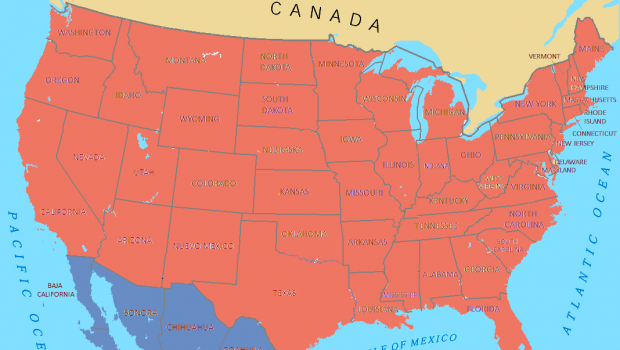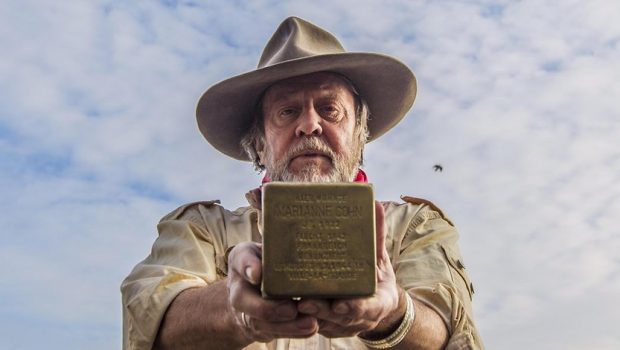How American Is It? Three Mexican Writers Look North
Marteen Van Delden
Sometimes as model, more often as menace, the United States looms large in the Mexican literary imagination. Mexican writers who look north of the border have responded with a mixture of horror and fascination, awe and disdain to a nation that seems astonishingly different from their own. In trying to capture the alien reality of the United States, they have offered both brutal polemics and lightfooted satire. Yet the histories of the two nations are so profoundly entangled with each other that it is not unusual for the sense of contrast and opposition to turn into something very different: a feeling of unavoidable interdependence.
One of the most compelling Mexican commentators on U.S. society and culture is the poet and essayist Octavio Paz. Over the course of his long career, Paz returned repeatedly to the question of the relations between Mexico and the United States, arguing again and again that the differences between the two countries were immense and perhaps even insuperable. Paz claimed that these differences involved each culture’s fundamental outlook on the world and believed that even a lessening of the vast economic disparities between the two nations would fail to erase these civilizational contrasts. One of the most polished and forceful statements of this position appears in The Labyrinth of Solitude (1950; 2nd ed. 1959), a meditation on the Mexican character that uses U.S. culture and society as a foil to throw its main subject into sharper relief.
Near the beginning of his essay Paz mentions that many of his ideas about Mexico took shape during a two-year period of residence in the United States in the 1940s: “whenever I attempted to examine North American life, anxious to discover its meaning, I encountered my own questioning image.” What begins as an encounter with the Other turns into a journey of self-discovery. From this point onward Paz develops a series of observations about North American society and culture, all of which contribute to a running opposition with Mexico. Americans are a pragmatic people with an optimistic view of the future and a can-do attitude toward society. They believe in progress and in their society’s ability to solve its problems and fulfill its ideals. During his sojourn in the United States Paz is struck above all by “the self-assurance and confidence of the people, by their apparent happiness and apparent adjustment to the world around them” (21). But the utilitarian, instrumentalist ethic that predominates in the United States comes at a huge cost. Paz views Americans as profoundly alienated creatures who in striving to impose their will on reality have created a world that has been emptied of its human dimension. Americans lack a sense of community, they repress the awareness of death, and they deny their own most profound instincts, especially those focused on the body. For Paz the United States is both like a desert (nothing grows there) and like a machine (everything works but nobody knows to what end).
In every possible way the Mexican, imbued with a sense of the sacred, immersed in a wider community, drenched in a tragic history, appears to be different from the American. And yet it is in the United States that Paz finds his first prototype of the Mexican. Why, one might ask, does The Labyrinth of Solitude open with an essay on the pachuco? What is the connection between the pachuco–a young Mexican American noted for his extravagant and eye-catching outfits–and the Mexican character? Paz describes the pachuco as someone who lives in an uneasy suspension between two worlds: the Mexico his ancestors left behind and the United States that rejects him for being different from the mainstream ideal. The pachuco is an orphan who “has lost his whole inheritance: language, religion, customs, beliefs” (15). And it is precisely this sense of abandonment and solitude that he shares with the Mexican. After all, in Paz’s account, Mexican identity consists primarily in a search for identity. The Mexican is someone who feels that he has been torn away from some primordial matrix (the historical source of this feeling is the Conquest) and who is constantly striving to restore the ties that once bound him to the world. In the pachuco Paz sees an echo–or rather, an extreme version– of this situation. This means that the United States not only provides the epistemological support for Paz’s investigation (insofar as it is the encounter with the United States that triggers the author’s insights into his own identity as a Mexican), it also harbors within its borders the social sub-group–the pachucos–that constitutes the most vivid embodiment of what it means to be a Mexican. In sum, Mexicans are the opposite of Americans; yet it is as if they could not exist without them.
In his 1982 novel Ciudades desiertas (Desert Cities, 1982) José Agustín also relies on the metaphor of the desert to capture the American way of life. The story of Susana, a Mexican writer who travels to the United States to participate in a writer’s program at the University of Arcadia, and her husband Eligio, who eventually follows her north only to find that she has become involved with another man, Ciudades desiertas treats the American backdrop against which the couple’s matrimonial difficulties play out with a mixture of mockery and dismay. Again and again, the narrator zeroes in on the emptiness and sterility the Mexican characters encounter wherever they go during their American sojourn. As he drives through the outskirts of Santa Fe, New Mexico, Eligio is struck by how devoid the urban landscape is of a sense of history, a feeling for beauty, or a simple human vibrancy: “Everywhere the same wide avenues […] as usual, no roundabouts, no dividers, no flowers, no statues, only kilometers of asphalt […] empty parks, streets used only by cars, without pedestrians or dogs or cats or street vendors or small stores.” In an earlier scene, as he is walking through the Chicago airport, Eligio is taken aback by how silent the terminal is: “It seemed to Eligio that there was something abnormal about the Chicago airport… It took him a long time to realize there was a very strange silence there, how could that enormous, frighteningly long hangar, with bars, restaurants, telephone booths, dull shops selling gringo curios, loudspeakers and incomprehensible machines be so silent? […] that airport was terrifying […] it was as if there was nothing there: a huge freezer” (51-52). Susana sums up the Mexican perspective in Ciudades desiertaswhen she observes that in the United States “nothing is sacred, everything is empty” (77).
In visiting the United States, one will, of course encounter people as well as places. In Ciudades desiertas, the role of the typical American is played by Becky, an assistant to the writer’s program at the University of Arcadia whose task it is to familiarize the visitors from abroad with their new surroundings. The narrator describes her as “a cold and talkative girl with large glasses and a gift-wrapped friendliness” (13). Becky tries hard to be cordial and helpful; unfortunately, she cannot help coming across as pedantic, humorless, and rigid. Oddly combining individualism and authoritarianism Becky loves telling people what to do, including telling them not to let anyone tell them what to do. Her endless chatter is a troubling mixture of p.r. (“In the elevator, Becky boasted that the Kitty Hawk had a jacuzzi, a sauna and an indoor pool, you can swim while it’s snowing outside, isn’t it wonderful?” 16) and reminders to follow the rules (“Becky handed them two official-sized envelopes with the first checks which they should by no means fold because that’s what the bank’s computer required” 18). Underneath it all the reader senses a sadistic streak, as when Becky explains with an unmistakable tone of relish the possible consequences of not following proper protocol with the immigration authorities at the airport: “all travelers have to state whether they’re carrying firearms and there are always some clowns who answer yes, sadly enough they’re usually people from our program, and the security agents take them away and give them a very hard time” (13).
Becky is one of those self-satisfied Americans who think their country is “the navel of the world” (104). But Agustín also captures a different type in Ciudades desiertas: the self-critical American who repudiates his or her own country and idealizes other countries, especially those regarded as primitive or pre-modern. As he chases his wife across the country, Eligio becomes involved with Irene, a young American woman who reflects this “alternative” outlook. Irene is attracted to Eligio because of his Indian looks: “she said that Eligio looked like an Aztec idol, an obsidian sculpture, she had never met anyone with such a pure and handsome Indian look” (100). Her views of Mexico have been shaped by her readings of Malcolm Lowry, D.H. Lawrence, Artaud, Carlos Castaneda and other propagators of the longstanding myth of “Mexico-as-land-of death-infernal-paradise” (176). Eligio is more than a little perplexed by Irene. He is impressed by her independence and her simple, practical sense. But he fully realizes that she is projecting her own longing for escape onto Eligio, and when one day she lectures him about the need for Mexicans to respect their indigenous roots, he becomes exasperated. In a way Irene is not so different from Becky with her conviction that she always knows best. When Eligio meets some of Irene’s friends in a bar in Santa Fe, his sympathy for their ideas–they attack Reagan and support left-wing movements in Latin America–is nullified by his irritation at their attitudes: “Deep down, Eligio thought, these kids still think that this huge refrigerator is the true center of the world and that it always will be, poor idiots” (182).
So is Ciudades desiertas unabashedly and unremittingly hostile to the United States? In actual fact, things are not so simple. For one thing, Eligio, through whom most of the novel’s perceptions of the United States are filtered, is not an altogether reliable observer–something even he himself is aware of. Toward the end of his stay in the United States Eligio’s irritation has become so intense that even the fact that Irene’s friends speak in English enrages him. But a moment later we see Eligio feeling dismay at his own intolerance (183). There is always an element of performance and exaggeration in his attitudes and everything he says needs to be taken with a grain of salt. Moreover, the novel itself is suffused with references to American cultural products and traditions, in a way that implicitly calls into question the text’s own anti- Americanism. Consider the fact that the epigraph to Ciudades desiertas comes from a song by the American rock band Cream, and that in its very narrative structure the novel is highly reminiscent of the very American genre of the road novel. True, Agustín satirizes the American counter-culture in his treatment of Irene and her friends, yet it is impossible to read this novel without recognizing that the author’s own sensibility has been profoundly shaped by that same counter-culture.
It may not be entirely accurate to describe Ricardo Aguilar Melantzón (1947-2004) as a Mexican writer who looks north toward the United States, since he was in fact a U.S. citizen who for a large part of his life lived and worked north of the border. Still, the fact that he wrote in Spanish and published his work in Mexico, and that the themes he explored in his work echoed those of writers such as Paz and Agustín, means that he is very much part of the Mexican literary tradition.
In examining the contrasts between Mexico and the United States, many observers rely on broad generalizations about Catholic and Protestant cultures, or modern and pre-modern societies. One of the advantages of the novel as a genre is that its focus on concrete experience helps bring these abstract notions about cultural difference down to earth. And when it comes to exploring the minute details of U.S.-Mexican inter-cultural relations it is hard to think of a work as rich and suggestive as Aguilar’s autobiographical novel A barlovento (To Windward 1999; 2nd ed. 2003). Consisting of narrative fragments that read very much like entries in a diary, the bulk of Aguilar’s novel describes episodes from the narrator’s life during the 1980s and 1990s, as he shuttles back and forth between jobs and residences on both sides of the border in the El Paso- Ciudad Juárez metropolitan area. The novel’s narrator describes the differences between the two countries in an extraordinarily direct, sensorial fashion.
He complains, of course, about American food: “it’s the exact same corn, bean or chili pepper, the same fruit or whatever you want but it seems to me that over here everything tastes like a rag, the bananas are bright green, like guanabanas, the apples taste sandy, I get the impression that they confuse green lemons with yellow limes, and chili peppers taste sweet, can you believe it?” He is troubled by the fact that there are no pedestrians in the streets of the towns and cities north of the border. When the narrator and his wife go for a little stroll after dark in Las Cruces, New Mexico, where he has just moved to take up a teaching position, the streets are empty, stripped of life: “Rosi asks me what’s going on, are our countrymen over here dead or what, what are they doing at eight or nine in the evening hiding in their digs or under the mattress or wherever […] our neighbors hide from us or stare at us as if they’re wondering what we’re doing going for a walk in the dark” (344). He remarks on the differences in what he calls “the physiognomies of the buildings” (389) in the two countries. In Juárez the narrator sees so many and such an immense variety of window bars on people’s homes that he describes it as “a caged city” (390). On the other side of the border, of course, there is nothing of the kind. All you have to do is travel a few miles north for the connotations of certain architectural details to change completely: “over here whenever you see a window without bars you start thinking ‘Gee, someone can get in through there.’ Over there you see a house with bars on its windows and you say to yourself: ‘Gee, that’s dangerous. If there’s a fire, how are they going to get out?’” (390). In Mexico, the focus is on protecting oneself against crime; in the United States, on accident prevention. Even sleeping turns out to be a completely different experience depending on which side of the border one happens to be lying down: “because the beds are very different, the one over there is hard as a plank and we’re used to sleeping each one on our own side, over there the bed is really soft and we sleep in opposite directions” (393). The narrator also contrasts American silence (“over there there’s a highway a couple of blocks yet we don’t hear a thing”) with Mexican noise (“over here the traffic is constant and we hear everything all the time” 393); the lack of olfactory pleasures to be found in America (“Over here it’s neither fish nor fowl. Yesterday I was thinking to myself in the supermarket what does it smell like here? And I had to say that it doesn’t smell like anything at all”) with the rich palette of smells he encounters in Mexico (“Over there I’ve been getting used to normal smells again, the smell of ink, of oranges both fresh and overripe, of toasted chili pepper, of newly baked bread” 407). The narrator does not express a preference for the Mexican way in every single case, yet in the end the long series of cultural contrasts in A barlovento resolves itself into a fundamental opposition between a Mexican world that is filled with life, where the narrator feels “saturated with human geography” (343), and an American space that lacks the same kind of sensory plenitude.
Aguilar’s vision of the differences between the two countries is just as stark as Paz’s and Agustín’s. At the same time the sense of the interconnectedness of the United States and Mexico is even more evident in A barlovento than in The Labyrinth of Solitude and Ciudades desiertas. After all, Aguilar wrote most of his novel in the United States, where he himself chose to live.
Posted: April 4, 2012 at 4:03 am










